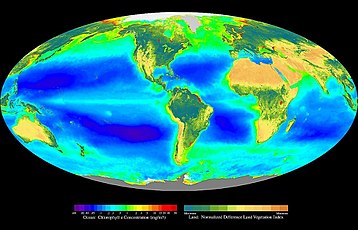자료: Wikipedia, http://en.wikipedia.org/wiki/Biosphere
For other uses, see Biosphere (disambiguation).
The biospheres is the global sum of all ecosystems. It can also be called the zone of life on Earth. From the broadest biophysiological point of view, the biosphere is the global ecological system integrating all living beings and their relationships, including their interaction with the elements of the lithosphere, hydrosphere, and atmosphere. The biosphere is postulated to have evolved, beginning through a process of biogenesis or biopoesis, at least some 3.5 billion years ago.[1]
Contents[hide] |
[edit]Origin and use of the term
The term "biosphere" was coined by geologist Eduard Suess in 1875, which he defined as:[2]
"The place on Earth's surface where life dwells."
While this concept has a geological origin, it is an indication of the impact of both Darwin and Maury on the earth sciences. The biosphere's ecological context comes from the 1920s (see Vladimir I. Vernadsky), preceding the 1935 introduction of the term "ecosystem" by Sir Arthur Tansley (see ecology history). Vernadsky defined ecology as the science of the biosphere. It is an interdisciplinary concept for integrating astronomy, geophysics, meteorology, biogeography, evolution, geology, geochemistry, hydrology and, generally speaking, all life and earth sciences.
[edit]Gaia hypothesis
The concept that the biosphere is itself a living organism, either actually or metaphorically, is known as the Gaia hypothesis.
James Lovelock, an atmospheric scientist from the United Kingdom, proposed the Gaia hypothesis to explain how biotic and abiotic factors interact in the biosphere. This hypothesis considers Earth itself a kind of living organism. Its atmosphere, geosphere, and hydrosphere are cooperating systems that yield a biosphere full of life. In the early 1970s, Lynn Margulis, a microbiologist from the United States, added to the hypothesis, specifically noting the ties between the biosphere and other Earth systems. For example, when carbon dioxide levels increase in the atmosphere, plants grow more quickly. As their growth continues, they remove more and more carbon dioxide from the atmosphere.
Many scientists are now involved in new fields of study that examine interactions between biotic and abiotic factors in the biosphere, such as geobiology and geomicrobiology.
Ecosystems occur when communities and their physical environment work together as a system. The difference between this and a biosphere is simple, the biosphere is everything in general terms. (이하 생략)





댓글 없음:
댓글 쓰기